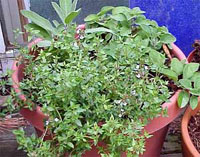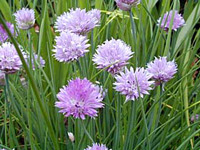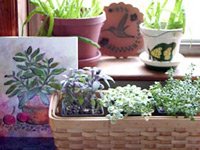by Ellen Ogden
My cooking often starts with the same routine: I heat a little olive oil in a pan, chop an onion and some garlic, and start to sauté. While the kitchen fills with a luscious aroma, I run to the garden to see what I can harvest and cook. The ingredients, rather than a recipe, inspire my cooking. Once I've gathered the veggies, I head for the herb patch. Mixing and matching ingredients with a patchwork of herbs can elevate any recipe to a work of art.
I first learned to cook in my mother's kitchen, where she kept jars of store-bought dried herbs in a drawer. I spent hours investigating this drawer filled with a world of exotic scents, from curry powder to oregano. It became a personal challenge to memorize the aroma of each herb and match it with the name on the jar. I'd unscrew the top, pour some herbs into the palm of my hand, gently crush them between my fingers, and breathe in.

Herbs for cooking are easy to grow in containers. Mix and match tall herbs, such as basil, with cascading herbs, such as oregano and thyme.
My interest in culinary herbs developed further when I planted my first herb garden in the early 1980s. I measured a 6' x 6' plot with sticks and a string and removed the layer of turf with a sharp edged spade. I double dug the soil to create a loose pile, then supplemented with compost. I proceeded to plant basil, summer savory, thyme, dill, and marjoram. I learned that the flavor of a fresh herb often has little in common with its dried counterpart. Fresh herbs are subtle and complex, while dried herbs can be bitter and intense.
I spent most of that summer tending my vegetable garden located near the house and left the herbs to grow on their own. Needless to say, the herb garden didn't thrive. The times I did throw my attention to the herbs I spent my time battling the weeds that were taking over. Plus, the watering hose didn't quite reach the herb garden, so the plants were frequently thirsty. To my amazement, despite these challenges many of the herbs thrived. I harvested fresh herbs throughout the summer and made bundles to dry over the winter, hanging them from the rafters in the kitchen.
Growing HerbsMy negligence actually was a stroke of luck. I've found out that most herbs thrive with some neglect. Obviously you can't let weeds take over or not water at all. But I found pampering herbs by feeding them a steady diet of nutrients, for example, robs them of their essential oils — the component that makes them so valuable in the kitchen. So, I skip the chemical fertilizer and use an organic soil mix that provides nutrition slowly. The lack of water doesn't hurt my Mediterranean herbs either. Thyme, oregano, and marjoram like growing in well-drained soil that stays on the dry side.

Culinary herbs, such as chives, are beautiful and edible. Chive flowers are edible too!
You can grow herbs almost anywhere. You don't need an in-ground garden; herbs thrive in containers. I grow herbs in pots on my deck and tuck herb plants into window boxes. Most annual herbs, including dill, basil, and cilantro; and some perennial herbs, such as chives, rosemary, and sage, will grow effortlessly in containers. Others, such as tarragon and lavender, do best transplanted into the garden.
While many herbs can be started from seed, I often buy plants to give me a jump on the season. If I'm growing them in containers, I begin by sprinkling the bottom of each pot with a handful of small pebbles. I use a potting mix made from one part sand blended with three parts organic potting soil. Setting the plants in the container at the same height as they were in their original pots, I use the potting soil to fill in around the root ball. Then I place the pots in full sun and water as needed. Frequent harvesting encourages annual herbs, such as basil, to produce new growth, so I pinch the tops before flowers appear.

Even if you don't have room outdoors for herbs, you can grow small pots of these delicious plants in a sunny window in summer.
A scattering of dill, sprigs of rosemary, and rosettes of spicy globe basil highlight a summer salad or a simple bowl of pasta. In fact, fresh herbs are among the most satisfying plants to grow, since they will last all summer and naturally enhance recipes with vibrant color, texture, and aroma.
In the kitchen, treat basil and other leafy herbs like a fresh bouquet of flowers: harvest in the morning and place in a jar of water on the counter. If you choose to refrigerate basil, wrap it in plastic or the leaves will turn black. Parsley, dill, and cilantro are best used right away, snipped into fine pieces with scissors. Any extra can be wrapped in a moist paper towel and tucked away in the refrigerator. For drying, trim the leaves from woody-stemmed herbs, such as rosemary and thyme, or bundle stems together and hang upside down.
A few years back, my mother gave up that old herb drawer in favor of the real thing. Just outside her kitchen door she has a raised bed filled with billowing tufts of tarragon, spikes of rosemary, and drifts of oregano interspersed with low-growing curly chives and thyme. Now the only herbs in her jars are ones harvested fresh from her own garden.
Ellen Ecker Ogden is a garden writer and cookbook author based in Vermont. She periodically writes Food for Thought essays about gardening, food, and related subjects for the Edible Landscaping newsletter.
 Charlie Nardozzi is an award winning, nationally recognized garden writer, speaker, radio, and television personality. He has worked for more than 30 years bringing expert gardening information to home gardeners through radio, television, talks, tours, on-line, and the printed page. Charlie delights in making gardening information simple, easy, fun and accessible to everyone. He's the author of 6 books, has three radio shows in New England and a TV show. He leads Garden Tours around the world and consults with organizations and companies about gardening programs. See more about him at Gardening With Charlie.
Charlie Nardozzi is an award winning, nationally recognized garden writer, speaker, radio, and television personality. He has worked for more than 30 years bringing expert gardening information to home gardeners through radio, television, talks, tours, on-line, and the printed page. Charlie delights in making gardening information simple, easy, fun and accessible to everyone. He's the author of 6 books, has three radio shows in New England and a TV show. He leads Garden Tours around the world and consults with organizations and companies about gardening programs. See more about him at Gardening With Charlie.
 Victory Seed Company has all the seeds you want for your best garden in 2024.
Victory Seed Company has all the seeds you want for your best garden in 2024.
For 25 years, the family-owned Victory Seed Company has provided the highest quality vegetable, herb and flower seeds to families across the country. We are passionate about providing you the best seeds available that give excellent germination, robust plants, and the harvest you want. With a catalog of over a thousand varieties, we have everything, and our prices are the kinds that we'd want to pay. We have hundreds of yesterday's heirloom vegetables, as well as today's award winning hybrid selections. Get to know us by visiting our website and browsing through our online vegetable seed catalog.